Dexamethasone downregulates expression of carbonic anhydrase IX via HIF-1α and NF-κB-dependent mechanisms
- Authors:
- Veronika Simko
- Martina Takacova
- Michaela Debreova
- Katarina Laposova
- Elena Ondriskova-Panisova
- Silvia Pastorekova
- Lucia Csaderova
- Jaromir Pastorek
-
Affiliations: Institute of Virology, Biomedical Research Center, Slovak Academy of Sciences, Bratislava, Slovak Republic - Published online on: July 14, 2016 https://doi.org/10.3892/ijo.2016.3621
- Pages: 1277-1288
-
Copyright: © Simko et al. This is an open access article distributed under the terms of Creative Commons Attribution License.
This article is mentioned in:
Abstract
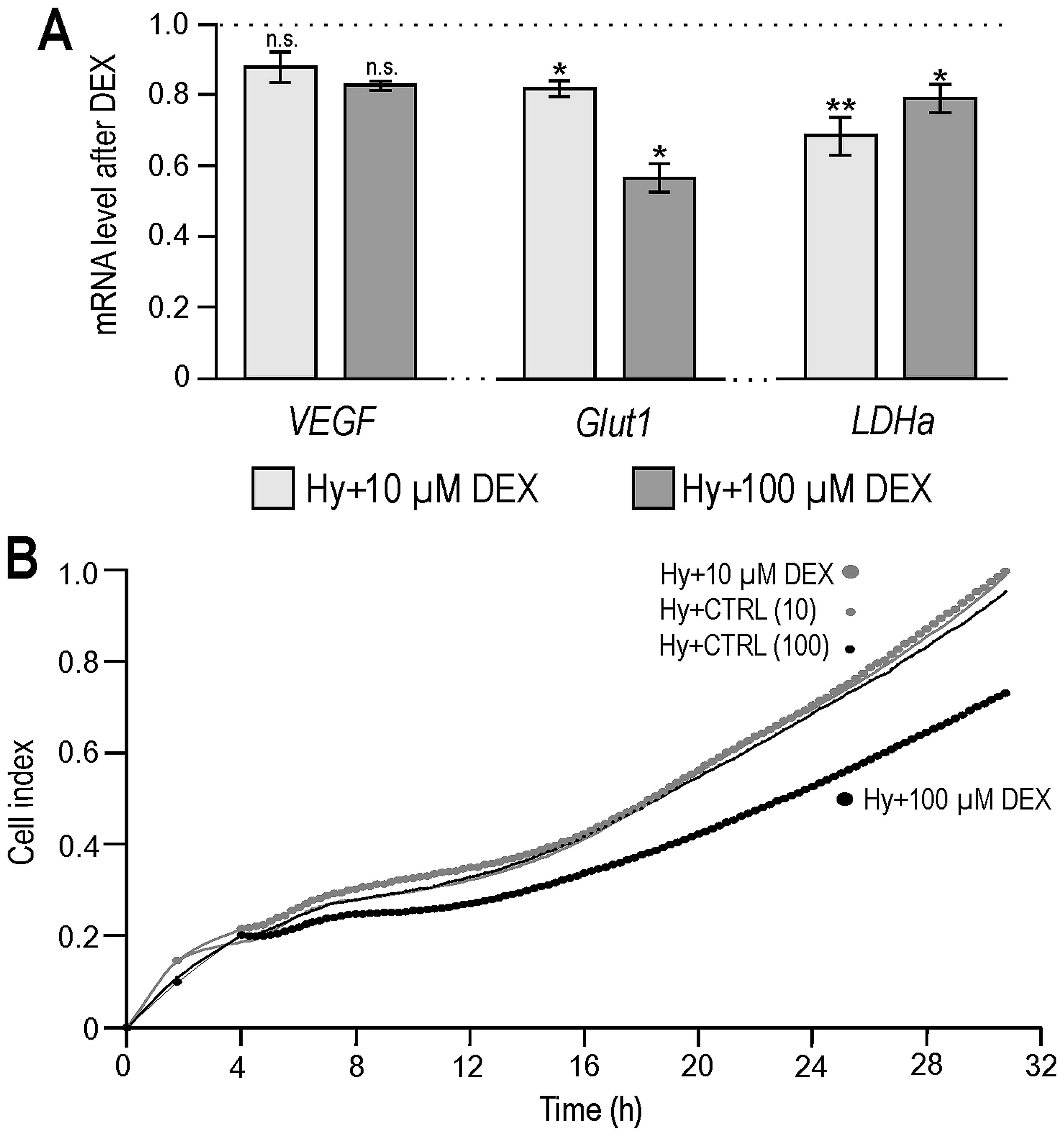 |
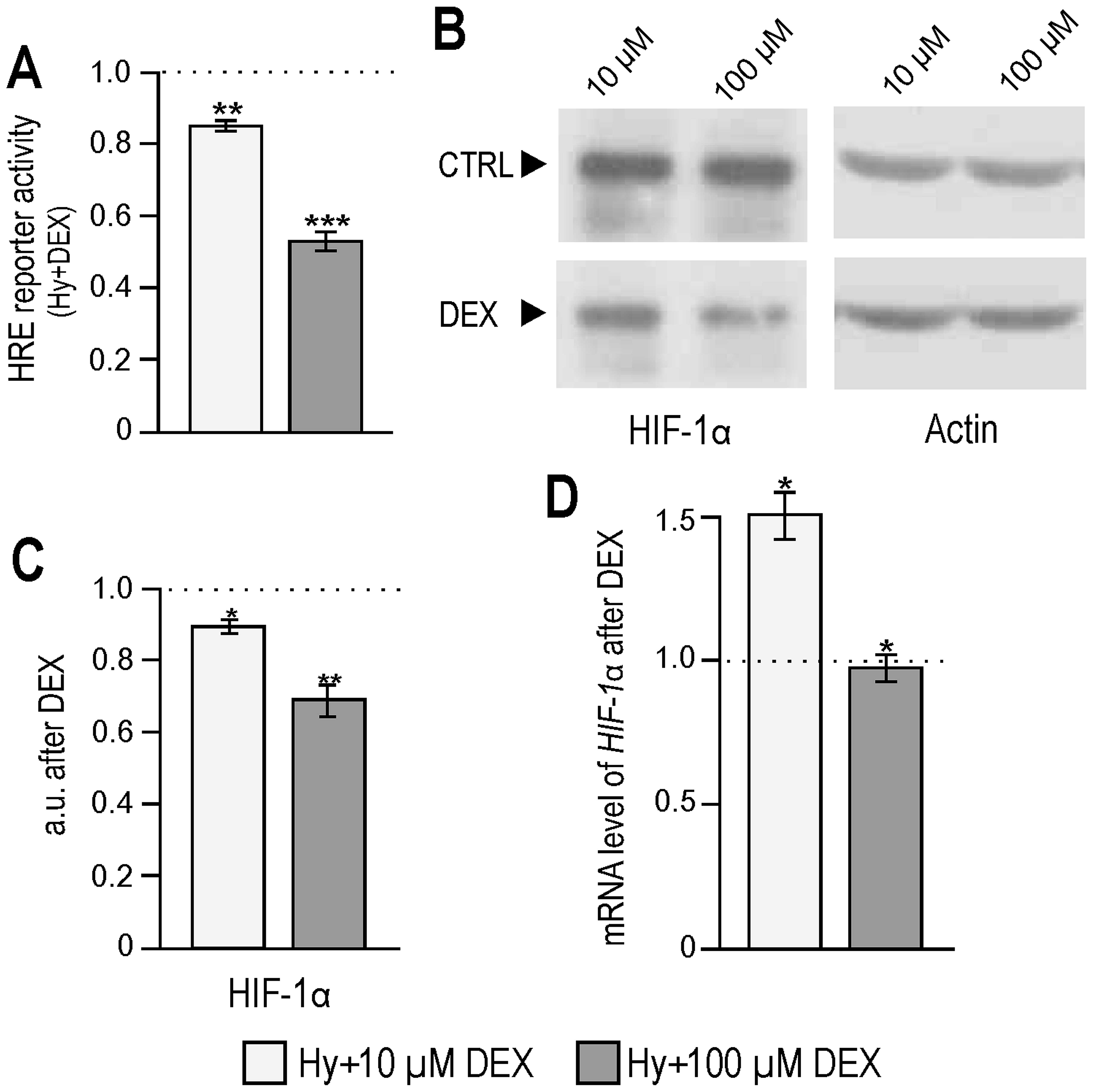 |
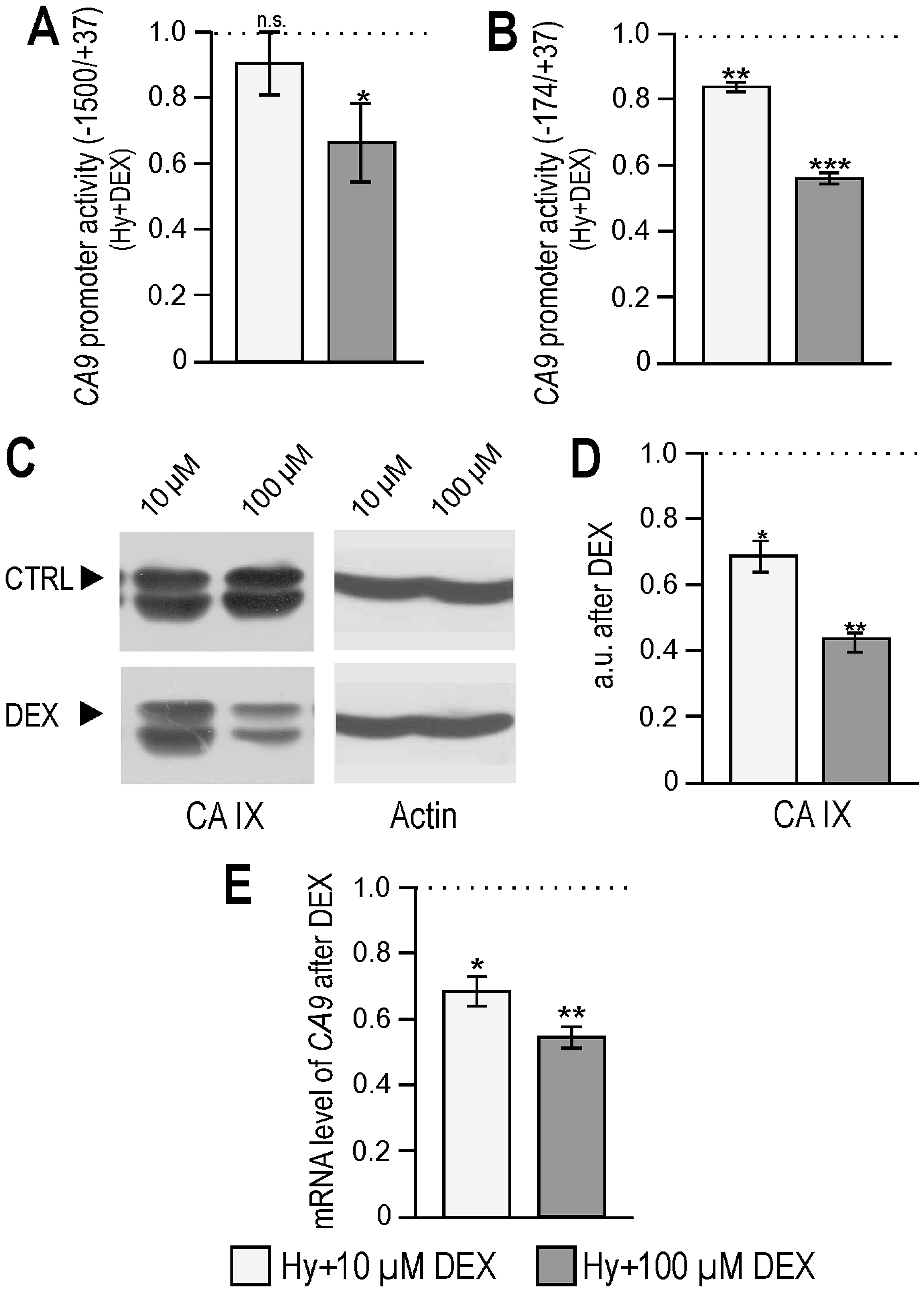 |
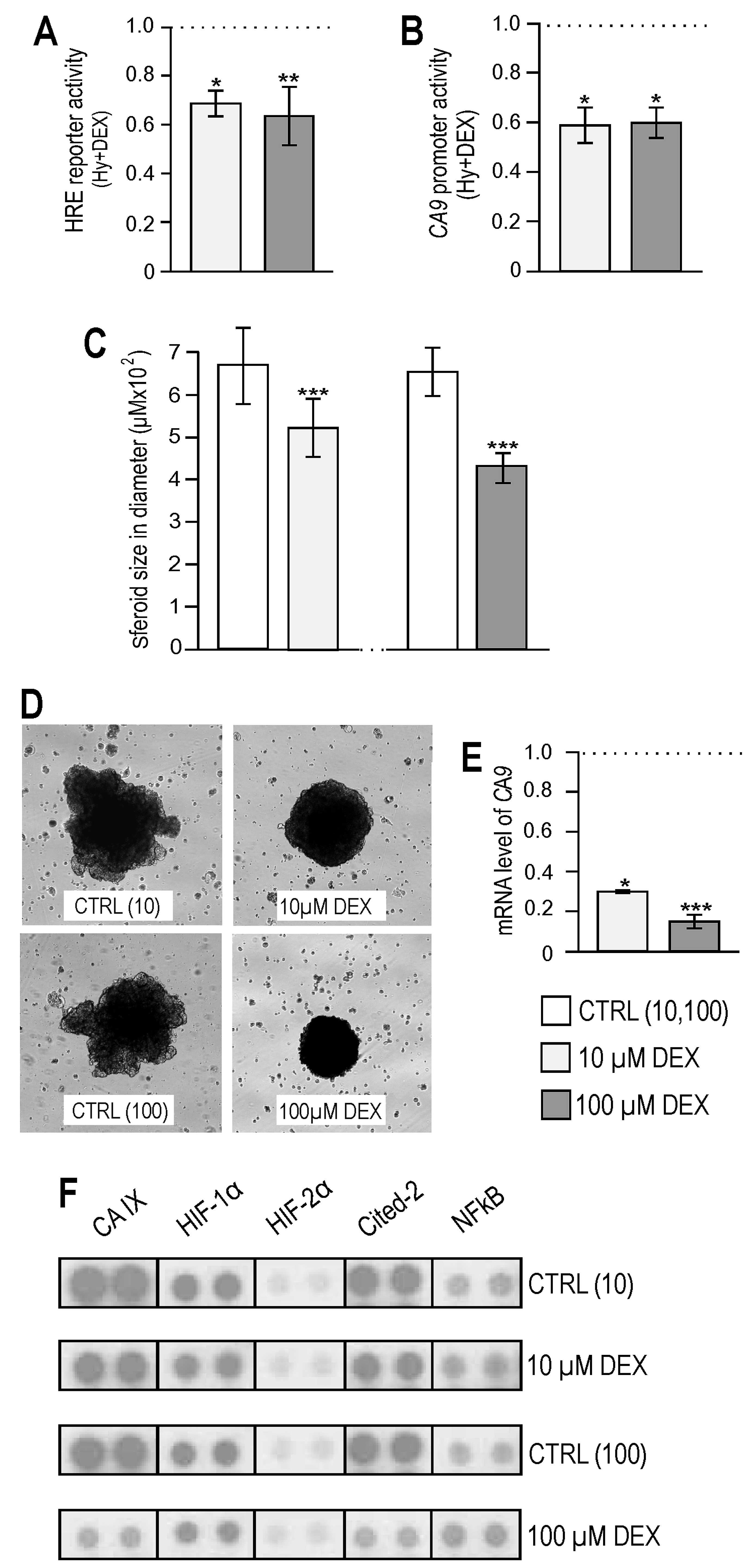 |
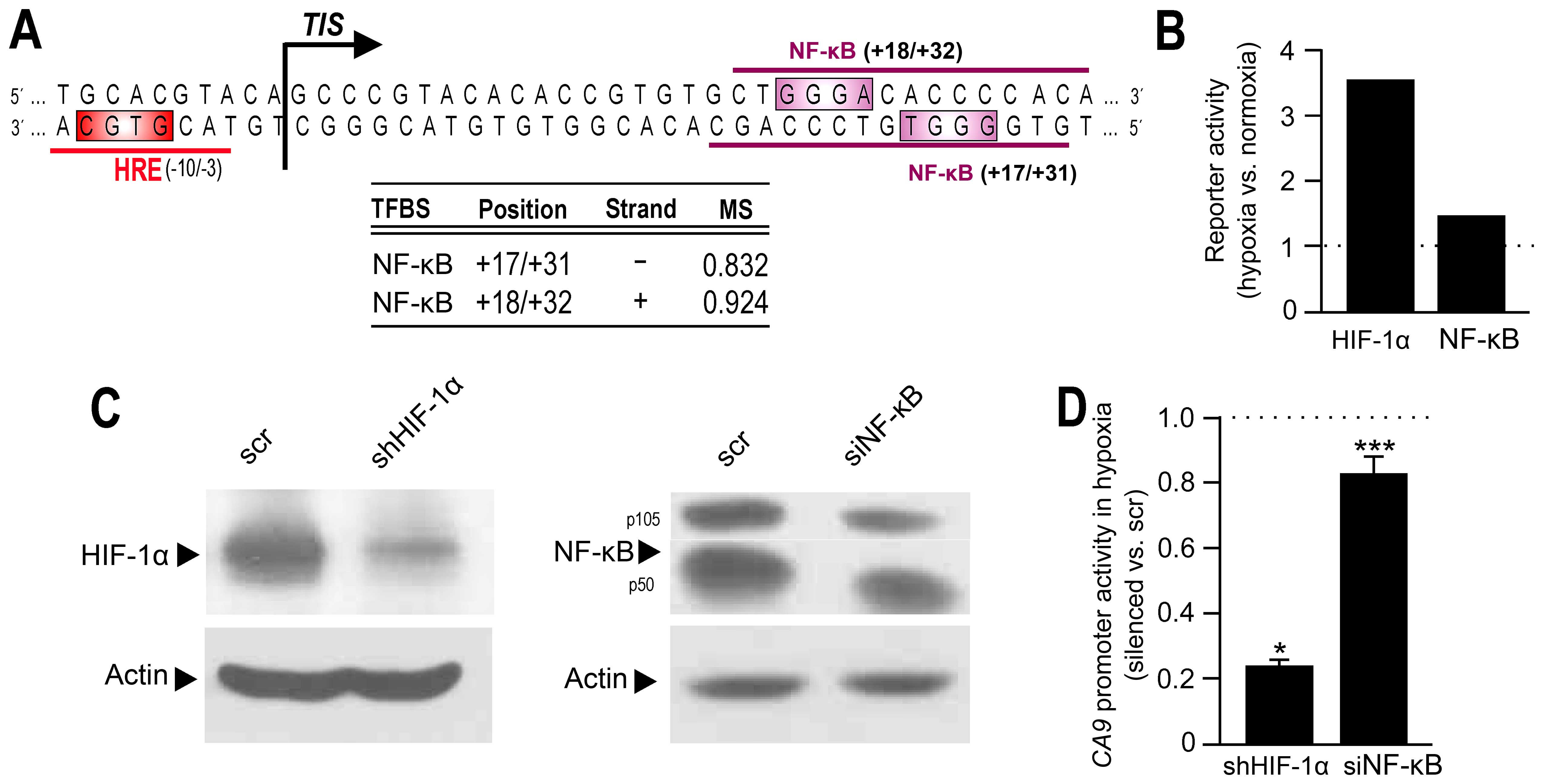 |
 |
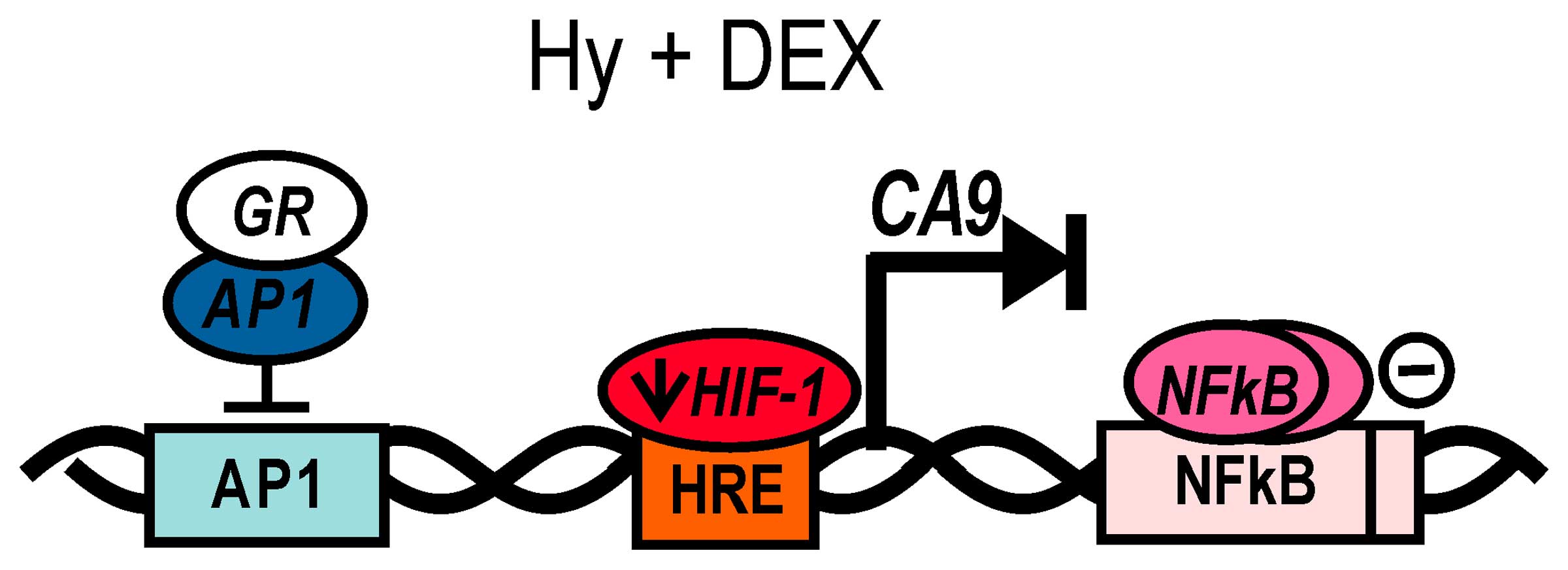 |
|
Semenza GL: Targeting HIF-1 for cancer therapy. Nat Rev Cancer. 3:721–732. 2003. View Article : Google Scholar : PubMed/NCBI | |
|
Lendahl U, Lee KL, Yang H and Poellinger L: Generating specificity and diversity in the transcriptional response to hypoxia. Nat Rev Genet. 10:821–832. 2009. View Article : Google Scholar : PubMed/NCBI | |
|
Pastorek J and Pastorekova S: Hypoxia-induced carbonic anhydrase IX as a target for cancer therapy: From biology to clinical use. Semin Cancer Biol. 31:52–64. 2015. View Article : Google Scholar | |
|
Ditte P, Dequiedt F, Svastova E, Hulikova A, Ohradanova-Repic A, Zatovicova M, Csaderova L, Kopacek J, Supuran CT, Pastorekova S, et al: Phosphorylation of carbonic anhydrase IX controls its ability to mediate extracellular acidification in hypoxic tumors. Cancer Res. 71:7558–7567. 2011. View Article : Google Scholar : PubMed/NCBI | |
|
Svastova E, Witarski W, Csaderova L, Kosik I, Skvarkova L, Hulikova A, Zatovicova M, Barathova M, Kopacek J, Pastorek J, et al: Carbonic anhydrase IX interacts with bicarbonate transporters in lamellipodia and increases cell migration via its catalytic domain. J Biol Chem. 287:3392–3402. 2012. View Article : Google Scholar : | |
|
Csaderova L, Debreova M, Radvak P, Stano M, Vrestiakova M, Kopacek J, Pastorekova S and Svastova E: The effect of carbonic anhydrase IX on focal contacts during cell spreading and migration. Front Physiol. 4:2712013. View Article : Google Scholar : PubMed/NCBI | |
|
Wykoff CC, Beasley NJ, Watson PH, Turner KJ, Pastorek J, Sibtain A, Wilson GD, Turley H, Talks KL, Maxwell PH, et al: Hypoxia-inducible expression of tumor-associated carbonic anhydrases. Cancer Res. 60:7075–7083. 2000. | |
|
Zatovicova M, Jelenska L, Hulikova A, Csaderova L, Ditte Z, Ditte P, Goliasova T, Pastorek J and Pastorekova S: Carbonic anhydrase IX as an anticancer therapy target: Preclinical evaluation of internalizing monoclonal antibody directed to catalytic domain. Curr Pharm Des. 16:3255–3263. 2010. View Article : Google Scholar : PubMed/NCBI | |
|
Dehne N and Brüne B: HIF-1 in the inflammatory microenvironment. Exp Cell Res. 315:1791–1797. 2009. View Article : Google Scholar : PubMed/NCBI | |
|
Eltzschig HK and Carmeliet P: Hypoxia and inflammation. N Engl J Med. 364:656–665. 2011. View Article : Google Scholar : PubMed/NCBI | |
|
Barnes PJ and Karin M: Nuclear factor-kappaB: A pivotal transcription factor in chronic inflammatory diseases. N Engl J Med. 336:1066–1071. 1997. View Article : Google Scholar : PubMed/NCBI | |
|
Taylor CT: Interdependent roles for hypoxia inducible factor and nuclear factor-kappaB in hypoxic inflammation. J Physiol. 586:4055–4059. 2008. View Article : Google Scholar : PubMed/NCBI | |
|
Chen ZJ, Parent L and Maniatis T: Site-specific phosphorylation of IkappaBalpha by a novel ubiquitination-dependent protein kinase activity. Cell. 84:853–862. 1996. View Article : Google Scholar : PubMed/NCBI | |
|
Israël A: The IKK complex: An integrator of all signals that activate NF-kappaB? Trends Cell Biol. 10:129–133. 2000. View Article : Google Scholar : PubMed/NCBI | |
|
Karin M: Nuclear factor-kappaB in cancer development and progression. Nature. 441:431–436. 2006. View Article : Google Scholar : PubMed/NCBI | |
|
Rutz HP: Effects of corticosteroid use on treatment of solid tumours. Lancet. 360:1969–1970. 2002. View Article : Google Scholar : PubMed/NCBI | |
|
Rutz HP and Herr I: Interference of glucocorticoids with apoptosis signaling and host-tumor interactions. Cancer Biol Ther. 3:715–718. 2004. View Article : Google Scholar : PubMed/NCBI | |
|
Schaaf MJ and Cidlowski JA: Molecular mechanisms of glucocorticoid action and resistance. J Steroid Biochem Mol Biol. 83:37–48. 2002. View Article : Google Scholar | |
|
Kim H, Lee JM, Park JS, Jo SA, Kim YO, Kim CW and Jo I: Dexamethasone coordinately regulates angiopoietin-1 and VEGF: A mechanism of glucocorticoid-induced stabilization of blood-brain barrier. Biochem Biophys Res Commun. 372:243–248. 2008. View Article : Google Scholar : PubMed/NCBI | |
|
Hata Y, Sassa Y, Kita T, Miura M, Kano K, Kawahara S, Arita R, Nakao S, Shih JL and Ishibashi T: Vascular endothelial growth factor expression by hyalocytes and its regulation by glucocorticoid. Br J Ophthalmol. 92:1540–1544. 2008. View Article : Google Scholar : PubMed/NCBI | |
|
Iwai A, Fujii Y, Kawakami S, Takazawa R, Kageyama Y, Yoshida MA and Kihara K: Down-regulation of vascular endothelial growth factor in renal cell carcinoma cells by glucocorticoids. Mol Cell Endocrinol. 226:11–17. 2004. View Article : Google Scholar : PubMed/NCBI | |
|
Machein MR, Kullmer J, Rönicke V, Machein U, Krieg M, Damert A, Breier G, Risau W and Plate KH: Differential downregulation of vascular endothelial growth factor by dexamethasone in normoxic and hypoxic rat glioma cells. Neuropathol Appl Neurobiol. 25:104–112. 1999. View Article : Google Scholar : PubMed/NCBI | |
|
Yano A, Fujii Y, Iwai A, Kageyama Y and Kihara K: Glucocorticoids suppress tumor angiogenesis and in vivo growth of prostate cancer cells. Clin Cancer Res. 12:3003–3009. 2006. View Article : Google Scholar : PubMed/NCBI | |
|
Wu Y, Lucia K, Lange M, Kuhlen D, Stalla GK and Renner U: Hypoxia inducible factor-1 is involved in growth factor, glucocorticoid and hypoxia mediated regulation of vascular endothelial growth factor-A in human meningiomas. J Neurooncol. 119:263–273. 2014. View Article : Google Scholar : PubMed/NCBI | |
|
Bao Y, Lv F and Ma Y: Effect of dexamethasone on expression of hypoxia inducible factor-1α and vascular endothelial growth factor in hypoxic mice. Zhongguo Fei Ai Za Zhi. 9:143–146. 2006.(In Chinese). PubMed/NCBI | |
|
Leonard MO, Godson C, Brady HR and Taylor CT: Potentiation of glucocorticoid activity in hypoxia through induction of the glucocorticoid receptor. J Immunol. 174:2250–2257. 2005. View Article : Google Scholar : PubMed/NCBI | |
|
Kopacek J, Barathova M, Dequiedt F, Sepelakova J, Kettmann R, Pastorek J and Pastorekova S: MAPK pathway contributes to density- and hypoxia-induced expression of the tumor-associated carbonic anhydrase IX. Biochim Biophys Acta. 1729:41–49. 2005. View Article : Google Scholar : PubMed/NCBI | |
|
Kaluz S, Kaluzová M, Chrastina A, Olive PL, Pastoreková S, Pastorek J, Lerman MI and Stanbridge EJ: Lowered oxygen tension induces expression of the hypoxia marker MN/carbonic anhydrase IX in the absence of hypoxia-inducible factor 1 alpha stabilization: A role for phosphatidylinositol 3′-kinase. Cancer Res. 62:4469–4477. 2002.PubMed/NCBI | |
|
Cartharius K, Frech K, Grote K, Klocke B, Haltmeier M, Klingenhoff A, Frisch M, Bayerlein M and Werner T: MatInspector and beyond: Promoter analysis based on transcription factor binding sites. Bioinformatics. 21:2933–2942. 2005. View Article : Google Scholar : PubMed/NCBI | |
|
Quandt K, Frech K, Karas H, Wingender E and Werner T: MatInd and MatInspector: New fast and versatile tools for detection of consensus matches in nucleotide sequence data. Nucleic Acids Res. 23:4878–4884. 1995. View Article : Google Scholar : PubMed/NCBI | |
|
Abrahám IM, Meerlo P and Luiten PG: Concentration dependent actions of glucocorticoids on neuronal viability and survival. Dose Response. 4:38–54. 2006. View Article : Google Scholar | |
|
Cianchi F, Vinci MC, Supuran CT, Peruzzi B, De Giuli P, Fasolis G, Perigli G, Pastorekova S, Papucci L, Pini A, et al: Selective inhibition of carbonic anhydrase IX decreases cell proliferation and induces ceramide-mediated apoptosis in human cancer cells. J Pharmacol Exp Ther. 334:710–719. 2010. View Article : Google Scholar : PubMed/NCBI | |
|
Dubois L, Peeters S, Lieuwes NG, Geusens N, Thiry A, Wigfield S, Carta F, McIntyre A, Scozzafava A, Dogné JM, et al: Specific inhibition of carbonic anhydrase IX activity enhances the in vivo therapeutic effect of tumor irradiation. Radiother Oncol. 99:424–431. 2011. View Article : Google Scholar : PubMed/NCBI | |
|
Morris JC, Chiche J, Grellier C, Lopez M, Bornaghi LF, Maresca A, Supuran CT, Pouysségur J and Poulsen SA: Targeting hypoxic tumor cell viability with carbohydrate-based carbonic anhydrase IX and XII inhibitors. J Med Chem. 54:6905–6918. 2011. View Article : Google Scholar : PubMed/NCBI | |
|
Ikeda Y, Carson BS and Long DM: The effects of topical dexamethasone on experimental brain tumors and peritumoral brain edema. Acta Neurochir Suppl (Wien). 60:397–399. 1994. | |
|
Maxwell PH, Wiesener MS, Chang GW, Clifford SC, Vaux EC, Cockman ME, Wykoff CC, Pugh CW, Maher ER and Ratcliffe PJ: The tumour suppressor protein VHL targets hypoxia-inducible factors for oxygen-dependent proteolysis. Nature. 399:271–275. 1999. View Article : Google Scholar : PubMed/NCBI | |
|
Wiesener MS, Turley H, Allen WE, Willam C, Eckardt KU, Talks KL, Wood SM, Gatter KC, Harris AL, Pugh CW, et al: Induction of endothelial PAS domain protein-1 by hypoxia: Characterization and comparison with hypoxia-inducible factor-1alpha. Blood. 92:2260–2268. 1998.PubMed/NCBI | |
|
Culver C, Sundqvist A, Mudie S, Melvin A, Xirodimas D and Rocha S: Mechanism of hypoxia-induced NF-kappaB. Mol Cell Biol. 30:4901–4921. 2010. View Article : Google Scholar : PubMed/NCBI | |
|
Koong AC, Chen EY and Giaccia AJ: Hypoxia causes the activation of nuclear factor kappa B through the phosphorylation of I kappa B alpha on tyrosine residues. Cancer Res. 54:1425–1430. 1994.PubMed/NCBI | |
|
Badruddoja MA, Krouwer HG, Rand SD, Rebro KJ, Pathak AP and Schmainda KM: Antiangiogenic effects of dexamethasone in 9L gliosarcoma assessed by MRI cerebral blood volume maps. Neuro Oncol. 5:235–243. 2003. View Article : Google Scholar : PubMed/NCBI | |
|
van Uden P, Kenneth NS and Rocha S: Regulation of hypoxia-inducible factor-1alpha by NF-kappaB. Biochem J. 412:477–484. 2008. View Article : Google Scholar : PubMed/NCBI | |
|
Iyer NV, Leung SW and Semenza GL: The human hypoxia-inducible factor 1alpha gene: HIF1A structure and evolutionary conservation. Genomics. 52:159–165. 1998. View Article : Google Scholar : PubMed/NCBI | |
|
Minet E, Ernest I, Michel G, Roland I, Remacle J, Raes M and Michiels C: HIF1A gene transcription is dependent on a core promoter sequence encompassing activating and inhibiting sequences located upstream from the transcription initiation site and cis elements located within the 5′UTR. Biochem Biophys Res Commun. 261:534–540. 1999. View Article : Google Scholar : PubMed/NCBI | |
|
Niu G, Briggs J, Deng J, Ma Y, Lee H, Kortylewski M, Kujawski M, Kay H, Cress WD, Jove R, et al: Signal transducer and activator of transcription 3 is required for hypoxia-inducible factor-1alpha RNA expression in both tumor cells and tumor-associated myeloid cells. Mol Cancer Res. 6:1099–1105. 2008. View Article : Google Scholar : PubMed/NCBI | |
|
Bhattacharya S, Michels CL, Leung MK, Arany ZP, Kung AL and Livingston DM: Functional role of p35srj, a novel p300/CBP binding protein, during transactivation by HIF-1. Genes Dev. 13:64–75. 1999. View Article : Google Scholar : PubMed/NCBI | |
|
Hudson CC, Liu M, Chiang GG, Otterness DM, Loomis DC, Kaper F, Giaccia AJ and Abraham RT: Regulation of hypoxia-inducible factor 1alpha expression and function by the mammalian target of rapamycin. Mol Cell Biol. 22:7004–7014. 2002. View Article : Google Scholar : PubMed/NCBI | |
|
Treins C, Giorgetti-Peraldi S, Murdaca J, Semenza GL and Van Obberghen E: Insulin stimulates hypoxia-inducible factor 1 through a phosphatidylinositol 3-kinase/target of rapamycin-dependent signaling pathway. J Biol Chem. 277:27975–27981. 2002. View Article : Google Scholar : PubMed/NCBI | |
|
Wang H, Kubica N, Ellisen LW, Jefferson LS and Kimball SR: Dexamethasone represses signaling through the mammalian target of rapamycin in muscle cells by enhancing expression of REDD1. J Biol Chem. 281:39128–39134. 2006. View Article : Google Scholar : PubMed/NCBI | |
|
Zhou J, Schmid T, Frank R and Brüne B: PI3K/Akt is required for heat shock proteins to protect hypoxia-inducible factor 1alpha from pVHL-independent degradation. J Biol Chem. 279:13506–13513. 2004. View Article : Google Scholar : PubMed/NCBI | |
|
Katschinski DM, Le L, Schindler SG, Thomas T, Voss AK and Wenger RH: Interaction of the PAS B domain with HSP90 accelerates hypoxia-inducible factor-1alpha stabilization. Cell Physiol Biochem. 14:351–360. 2004. View Article : Google Scholar : PubMed/NCBI | |
|
Maheshwari M, Bhutani S, Das A, Mukherjee R, Sharma A, Kino Y, Nukina N and Jana NR: Dexamethasone induces heat shock response and slows down disease progression in mouse and fly models of Huntington's disease. Hum Mol Genet. 23:2737–2751. 2014. View Article : Google Scholar : PubMed/NCBI | |
|
Lim W, Park C, Shim MK, Lee YH, Lee YM and Lee Y: Glucocorticoids suppress hypoxia-induced COX-2 and hypoxia inducible factor-1α expression through the induction of glucocorticoid-induced leucine zipper. Br J Pharmacol. 171:735–745. 2014. View Article : Google Scholar : | |
|
Leis H, Page A, Ramírez A, Bravo A, Segrelles C, Paramio J, Barettino D, Jorcano JL and Pérez P: Glucocorticoid receptor counteracts tumorigenic activity of Akt in skin through interference with the phosphatidylinositol 3-kinase signaling pathway. Mol Endocrinol. 18:303–311. 2004. View Article : Google Scholar | |
|
Box AH and Demetrick DJ: Cell cycle kinase inhibitor expression and hypoxia-induced cell cycle arrest in human cancer cell lines. Carcinogenesis. 25:2325–2335. 2004. View Article : Google Scholar : PubMed/NCBI | |
|
Mottet D, Dumont V, Deccache Y, Demazy C, Ninane N, Raes M and Michiels C: Regulation of hypoxia-inducible factor-1alpha protein level during hypoxic conditions by the phosphatidylinositol 3-kinase/Akt/glycogen synthase kinase 3beta pathway in HepG2 cells. J Biol Chem. 278:31277–31285. 2003. View Article : Google Scholar : PubMed/NCBI | |
|
De Bosscher K, Vanden Berghe W and Haegeman G: The interplay between the glucocorticoid receptor and nuclear factor-kappaB or activator protein-1: Molecular mechanisms for gene repression. Endocr Rev. 24:488–522. 2003. View Article : Google Scholar : PubMed/NCBI | |
|
Kaluz S, Kaluzová M, Opavský R, Pastoreková S, Gibadulinová A, Dequiedt F, Kettmann R and Pastorek J: Transcriptional regulation of the MN/CA 9 gene coding for the tumor-associated carbonic anhydrase IX. Identification and characterization of a proximal silencer element. J Biol Chem. 274:32588–32595. 1999. View Article : Google Scholar : PubMed/NCBI | |
|
Ashburner BP, Westerheide SD and Baldwin AS Jr: The p65 (RelA) subunit of NF-kappaB interacts with the histone deacetylase (HDAC) corepressors HDAC1 and HDAC2 to negatively regulate gene expression. Mol Cell Biol. 21:7065–7077. 2001. View Article : Google Scholar : PubMed/NCBI | |
|
Baetz D, Regula KM, Ens K, Shaw J, Kothari S, Yurkova N and Kirshenbaum LA: Nuclear factor-kappaB-mediated cell survival involves transcriptional silencing of the mitochondrial death gene BNIP3 in ventricular myocytes. Circulation. 112:3777–3785. 2005. View Article : Google Scholar : PubMed/NCBI | |
|
Datta De D, Datta A, Bhattacharjya S and Roychoudhury S: NF-kappaB mediated transcriptional repression of acid modifying hormone gastrin. PLoS One. 8:e734092013. View Article : Google Scholar : PubMed/NCBI | |
|
Swietach P, Wigfield S, Cobden P, Supuran CT, Harris AL and Vaughan-Jones RD: Tumor-associated carbonic anhydrase 9 spatially coordinates intracellular pH in three-dimensional multicellular growths. J Biol Chem. 283:20473–20483. 2008. View Article : Google Scholar : PubMed/NCBI | |
|
Swietach P, Patiar S, Supuran CT, Harris AL and Vaughan-Jones RD: The role of carbonic anhydrase 9 in regulating extracellular and intracellular ph in three-dimensional tumor cell growths. J Biol Chem. 284:20299–20310. 2009. View Article : Google Scholar : PubMed/NCBI | |
|
Hulikova A, Harris AL, Vaughan-Jones RD and Swietach P: Regulation of intracellular pH in cancer cell lines under normoxia and hypoxia. J Cell Physiol. 228:743–752. 2013. View Article : Google Scholar | |
|
Ditte Z, Ditte P, Labudova M, Simko V, Iuliano F, Zatovicova M, Csaderova L, Pastorekova S and Pastorek J: Carnosine inhibits carbonic anhydrase IX-mediated extracellular acidosis and suppresses growth of HeLa tumor xenografts. BMC Cancer. 14:3582014. View Article : Google Scholar : PubMed/NCBI | |
|
Chiche J, Ilc K, Laferrière J, Trottier E, Dayan F, Mazure NM, Brahimi-Horn MC and Pouysségur J: Hypoxia-inducible carbonic anhydrase IX and XII promote tumor cell growth by counteracting acidosis through the regulation of the intracellular pH. Cancer Res. 69:358–368. 2009. View Article : Google Scholar : PubMed/NCBI | |
|
McIntyre A, Patiar S, Wigfield S, Li JL, Ledaki I, Turley H, Leek R, Snell C, Gatter K, Sly WS, et al: Carbonic anhydrase IX promotes tumor growth and necrosis in vivo and inhibition enhances anti-VEGF therapy. Clin Cancer Res. 18:3100–3111. 2012. View Article : Google Scholar : PubMed/NCBI | |
|
Ivanova L, Zandberga E, Siliņa K, Kalniņa Z, Ābols A, Endzeliņš E, Vendina I, Romanchikova N, Hegmane A, Trapencieris P, et al: Prognostic relevance of carbonic anhydrase IX expression is distinct in various subtypes of breast cancer and its silencing suppresses self-renewal capacity of breast cancer cells. Cancer Chemother Pharmacol. 75:235–246. 2015. View Article : Google Scholar | |
|
Mattern J, Büchler MW and Herr I: Cell cycle arrest by glucocorticoids may protect normal tissue and solid tumors from cancer therapy. Cancer Biol Ther. 6:1345–1354. 2007. View Article : Google Scholar : PubMed/NCBI | |
|
Takada Y, Bhardwaj A, Potdar P and Aggarwal BB: Nonsteroidal anti-inflammatory agents differ in their ability to suppress NF-kappaB activation, inhibition of expression of cyclooxygenase-2 and cyclin D1, and abrogation of tumor cell proliferation. Oncogene. 23:9247–9258. 2004.PubMed/NCBI | |
|
Wang ML, Chiou SH and Wu CW: Targeting cancer stem cells: Emerging role of Nanog transcription factor. Onco Targets Ther. 6:1207–1220. 2013.PubMed/NCBI | |
|
Dang CV: c-Myc target genes involved in cell growth, apoptosis, and metabolism. Mol Cell Biol. 19:1–11. 1999. View Article : Google Scholar | |
|
Lavia P and Jansen-Dürr P: E2F target genes and cell-cycle checkpoint control. BioEssays. 21:221–230. 1999. View Article : Google Scholar : PubMed/NCBI | |
|
Meyer C, Pries R and Wollenberg B: Established and novel NF-κB inhibitors lead to downregulation of TLR3 and the proliferation and cytokine secretion in HNSCC. Oral Oncol. 47:818–826. 2011. View Article : Google Scholar : PubMed/NCBI | |
|
Mayer A, Schneider F, Vaupel P, Sommer C and Schmidberger H: Differential expression of HIF-1 in glioblastoma multiforme and anaplastic astrocytoma. Int J Oncol. 41:1260–1270. 2012.PubMed/NCBI | |
|
Hussain SA, Ganesan R, Reynolds G, Gross L, Stevens A, Pastorek J, Murray PG, Perunovic B, Anwar MS, Billingham L, et al: Hypoxia-regulated carbonic anhydrase IX expression is associated with poor survival in patients with invasive breast cancer. Br J Cancer. 96:104–109. 2007. View Article : Google Scholar : PubMed/NCBI | |
|
Wykoff CC, Beasley N, Watson PH, Campo L, Chia SK, English R, Pastorek J, Sly WS, Ratcliffe P and Harris AL: Expression of the hypoxia-inducible and tumor-associated carbonic anhydrases in ductal carcinoma in situ of the breast. Am J Pathol. 158:1011–1019. 2001. View Article : Google Scholar : PubMed/NCBI | |
|
Chu CY, Jin YT, Zhang W, Yu J, Yang HP, Wang HY, Zhang ZJ, Liu XP and Zou Q: CA IX is upregulated in CoCl2-induced hypoxia and associated with cell invasive potential and a poor prognosis of breast cancer. Int J Oncol. 48:271–280. 2016. | |
|
Konno H, Ishii G, Nagai K, Yoshida J, Nishimura M, Nara M, Fujii T, Murata Y, Miyamoto H and Ochiai A: Carbonic anhydrase IX expression is associated with tumor progression and a poor prognosis of lung adenocarcinoma. Lung Cancer. 54:409–418. 2006. View Article : Google Scholar | |
|
Le QT, Kong C, Lavori PW, O'byrne K, Erler JT, Huang X, Chen Y, Cao H, Tibshirani R, Denko N, et al: Expression and prognostic significance of a panel of tissue hypoxia markers in head-and-neck squamous cell carcinomas. Int J Radiat Oncol Biol Phys. 69:167–175. 2007. View Article : Google Scholar : PubMed/NCBI | |
|
Haapasalo J, Hilvo M, Nordfors K, Haapasalo H, Parkkila S, Hyrskyluoto A, Rantala I, Waheed A, Sly WS, Pastorekova S, et al: Identification of an alternatively spliced isoform of carbonic anhydrase XII in diffusely infiltrating astrocytic gliomas. Neuro Oncol. 10:131–138. 2008. View Article : Google Scholar : PubMed/NCBI | |
|
Chen J, Röcken C, Hoffmann J, Krüger S, Lendeckel U, Rocco A, Pastorekova S, Malfertheiner P and Ebert MP: Expression of carbonic anhydrase 9 at the invasion front of gastric cancers. Gut. 54:920–927. 2005. View Article : Google Scholar : PubMed/NCBI | |
|
Stewart DJ, Nunez MI, Behrens C, Liu D, Lin YH, Lee JJ, Roth J, Heymach J, Swisher SG, Hong WK, et al: Membrane carbonic anhydrase IX expression and relapse risk in resected stage I–II non-small-cell lung cancer. J Thorac Oncol. 9:675–684. 2014. View Article : Google Scholar : PubMed/NCBI | |
|
Dubois L, Peeters SG, van Kuijk SJ, Yaromina A, Lieuwes NG, Saraya R, Biemans R, Rami M, Parvathaneni NK, Vullo D, et al: Targeting carbonic anhydrase IX by nitroimidazole based sulfamides enhances the therapeutic effect of tumor irradiation: A new concept of dual targeting drugs. Radiother Oncol. 108:523–528. 2013. View Article : Google Scholar : PubMed/NCBI | |
|
Wojtkowiak JW, Verduzco D, Schramm KJ and Gillies RJ: Drug resistance and cellular adaptation to tumor acidic pH microenvironment. Mol Pharm. 8:2032–2038. 2011. View Article : Google Scholar : PubMed/NCBI | |
|
Koukourakis MI, Giatromanolaki A, Danielidis V and Sivridis E: Hypoxia inducible factor (HIf1alpha and HIF2alpha) and carbonic anhydrase 9 (CA9) expression and response of head-neck cancer to hypofractionated and accelerated radiotherapy. Int J Radiat Biol. 84:47–52. 2008. View Article : Google Scholar | |
|
Lee-Kong SA, Ruby JA, Chessin DB, Pucciarelli S, Shia J, Riedel ER, Nitti D and Guillem JG: Hypoxia-related proteins in patients with rectal cancer undergoing neoadjuvant combined modality therapy. Dis Colon Rectum. 55:990–995. 2012. View Article : Google Scholar : PubMed/NCBI | |
|
Span PN, Bussink J, Manders P, Beex LV and Sweep CG: Carbonic anhydrase-9 expression levels and prognosis in human breast cancer: Association with treatment outcome. Br J Cancer. 89:271–276. 2003. View Article : Google Scholar : PubMed/NCBI | |
|
Tan EY, Yan M, Campo L, Han C, Takano E, Turley H, Candiloro I, Pezzella F, Gatter KC, Millar EK, et al: The key hypoxia regulated gene CAIX is upregulated in basal-like breast tumours and is associated with resistance to chemotherapy. Br J Cancer. 100:405–411. 2009. View Article : Google Scholar : PubMed/NCBI | |
|
Giatromanolaki A, Koukourakis MI, Sivridis E, Pastorek J, Wykoff CC, Gatter KC and Harris AL: Expression of hypoxia-inducible carbonic anhydrase-9 relates to angiogenic pathways and independently to poor outcome in non-small cell lung cancer. Cancer Res. 61:7992–7998. 2001.PubMed/NCBI |










